Green Roof Development in ASEAN Countries: The Challenges and Perspectives
Abstract
1. Introduction
2. Materials and Methods
3. Results
3.1. Mapping of Selected Literatures
3.2. Stages of Green Roofs in ASEAN Countries
3.3. Green Roof Performance in ASEAN Countries
3.3.1. Drivers of Green Roofs in ASEAN Countries
- Policy Pressure.
| Authors | Key Findings | Country | |
|---|---|---|---|
| Subsidy Scheme | Regulations and Standards | ||
| Ismail et al. [28] | The scheme supported 50% of green roof installation costs by Singapore National Parks (NParks) to encourage owners to have green roofs | Standards for Singapore GRs,
| Singapore |
| Fauzi et al. [29,30], Siew et al. [65], Zaid et al. [66] | None |
| Malaysia |
- Advance Innovation Technology.
3.3.2. Motivations for Green Roofs in ASEAN Countries
- Energy Efficiency.
- Urban Heat Island Mitigation.
- Outside Surface Temperature.
- 2.
- Indoor Room Temperature.
- Runoff Control.
- Storm Water Retention.
- 2.
- Runoff Water Quality.
- Biodiversity Increase.
3.3.3. Barriers to Green Roofs in ASEAN Countries
- Government Policy and Technology Barriers.
- Economy.
- Social Acceptability and Feasibility Issues in ASEAN Countries.
| Challenge | Brunei | Malaysia | Indonesia | Thailand | Vietnam | Myanmar | References |
|---|---|---|---|---|---|---|---|
| Lack of Interest using GRs | ✓ | ✓ | ✓ | ✓ | [48,52,104,105,106,107] | ||
| Lack of Guidelines | ✓ | ✓ | [67,102,108] | ||||
| Less Government Intensive | ✓ | ✓ | ✓ | [60,103,109] | |||
| High Installation Cost | ✓ | [110] | |||||
| Lack of Expertise | ✓ | [105,106] |
4. Discussion
4.1. Challenges of GR Development in ASEAN Countries
4.2. Perspective and Future Needs of GR Development in ASEAN Countries
- -
- GRs can reduce energy consumption in buildings by up to 57%, reduce roof surface temperatures when compared to bare roofs up to 23.8 °C, and reduce the room temperature to 14 °C. It should be noted that heating load reductions can be influenced by substrate [73], vegetation [76], and insulating material [81]. Some researchers describe alternative material such as lightweight concrete deck that can improve GR properties [40,51].
- -
- GRs aid in water management, owing to their high water retention potential and increased runoff quality. The application of GRs in ASEAN countries is highly appropriate due to the region’s abundant precipitation. GRs can control up to 98.8% of flood water retention. However, the retention is high only for low- to moderate-intensity rainfall. Countries with significant precipitation, such as the Philippines, are highly interested in GR water management research (e.g., as described in the case reported by Orozco [36]). The use of hydrogel to increase water retention on the substrate is an interesting innovation to be developed (from research by Asinas [57]). Other countries with heavy precipitation, such as Indonesia, are encouraged to conduct studies on the water management of GRs.
- -
- The present review study also signals biodiversity, which is the fact that GRs can promote urban biodiversity and enhanced habitat connectivity between flora and fauna as was shown in research in Singapore [113]. A habitat is created from many environmental factors. We found no literature on biodiversity in other ASEAN nations during our search. We need further research on the effect of environment and topography on the biodiversity of the GR.
- Investigating alternative materials that can enhance the efficacy of GRs and reduce installation costs.
- Developing intelligent technology that can expedite the retrieval of GR data in order to accelerate the pre-development, construction, and maintenance processes.
- Planning guidelines and economic schemes that can be referred to in the future when creating government regulations.
- Conducting research on the benefits of GRs at each city scale (e.g., residential buildings, commercial buildings, and high-rise buildings) to educate users on the advantages of GR use.
- At this time, numerous diverse data can be suggested for calculating the mean and median value for each parameter. Due to the heterogeneity of the parameters in the calculated studies, it was deemed statistically invalid to compute such values. Evaluation of performance can serve as an indicator for evaluating the performance of green roofs in ASEAN countries.
5. Conclusions
Author Contributions
Funding
Institutional Review Board Statement
Informed Consent Statement
Data Availability Statement
Acknowledgments
Conflicts of Interest
References
- Shao, H.; Kim, G. A Comprehensive Review of Different Types of Green Infrastructure to Mitigate Urban Heat Islands: Progress, Functions, and Benefits. Land 2022, 11, 1792. [Google Scholar] [CrossRef]
- Gaigbe-Togbe, V.; Bassarsky, L.; Gu, D.; Spoorenberg, T.; Zeifman, L. World Population Prospects 2022; United Nations: New York, NY, USA, 2022; ISBN 978-92-1-148373-4. [Google Scholar]
- Grullón-Penkova, I.F.; Zimmerman, J.K.; González, G. Green Roofs in the Tropics: Design Considerations and Vegetation Dynamics. Heliyon 2020, 6, e04712. [Google Scholar] [CrossRef] [PubMed]
- Mondal, M.S.H. The Implications of Population Growth and Climate Change on Sustainable Development in Bangladesh. Jamba J. Disaster Risk Stud. 2019, 11, 535. [Google Scholar] [CrossRef] [PubMed]
- Stone, B. Urban Sprawl and Air Quality in Large US Cities. J. Environ. Manag. 2008, 86, 688–698. [Google Scholar] [CrossRef] [PubMed]
- Vijayaraghavan, K. Green Roofs: A Critical Review on the Role of Components, Benefits, Limitations and Trends. Renew. Sustain. Energy Rev. 2016, 57, 740–752. [Google Scholar] [CrossRef]
- Auer, T.; Radi, M.; Brkovi, M. Green Facades and Living Walls—A Review Establishing the Classification of Construction Types and Mapping the Benefits. Sustainability 2019, 11, 4579. [Google Scholar] [CrossRef]
- Schade, J.; Lidelöw, S.; Lönnqvist, J. The Thermal Performance of a Green Roof on a Highly Insulated Building in a Sub-Arctic Climate. Energy Build. 2021, 241, 110961. [Google Scholar] [CrossRef]
- Samuel, K.A.; Bamfo-Agyei, E. Minimization of Heat Gains in Buildings: The Case of Domestic Buildings in Cape Coast Metropolis–Ghana. Int. J. Dev. Sustain. 2012, 1, 315–326. [Google Scholar] [CrossRef]
- Oberndorfer, E.; Lundholm, J.; Bass, B.; Coffman, R.R.; Doshi, H.; Dunnett, N.; Gaffin, S.; Köhler, M.; Liu, K.K.Y.; Rowe, B. Green Roofs as Urban Ecosystems: Ecological Structures, Functions, and Services. Bioscience 2007, 57, 823–833. [Google Scholar] [CrossRef]
- Berndtsson, J.C. Green Roof Performance towards Management of Runoff Water Quantity and Quality: A Review. Ecol. Eng. 2010, 36, 351–360. [Google Scholar] [CrossRef]
- Van Renterghem, T.; Botteldooren, D. In-Situ Measurements of Sound Propagating over Extensive Green Roofs. Build. Environ. 2011, 46, 729–738. [Google Scholar] [CrossRef]
- Pandit, R.; Laband, D.N. Energy Savings from Tree Shade. Ecol. Econ. 2010, 69, 1324–1329. [Google Scholar] [CrossRef]
- Akbari, H.; Pomerantz, M.; Taha, H. Cool Surfaces and Shade Trees to Reduce Energy Use and Improve Air Quality in Urban Areas. Sol. Energy 2001, 70, 295–310. [Google Scholar] [CrossRef]
- Liu, K.; Baskaran, B. Thermal Performance of Green Roofs through Field Evaluation. In Proceedings of the First North American Green Roof Infrastructure Conference, Awards and Trade Show, Chicago, IL, USA, 29–30 May 2003; pp. 1–10. [Google Scholar]
- Mohammed Ahmed, R.; Halil Alibaba, A.Z. An Evaluation of Green Roofing in Buildings. Int. J. Sci. Res. Publ. 2016, 6, 366–2250. [Google Scholar]
- Kosareo, L.; Ries, R. Comparative Environmental Life Cycle Assessment of Green Roofs. Build. Environ. 2007, 42, 2606–2613. [Google Scholar] [CrossRef]
- Li, H.; Ye, J. The Comparison of the Forms of Ecological Green Roof Based on the Full Life Cycle Theory. ICEOE 2011—2011 Int. Conf. Electron. Optoelectron. Proc. 2011, 1, V1-294–V1-296. [Google Scholar] [CrossRef]
- Grant, G.; Lane, C. Extensive Green Roofs in London. Urban Habitats 2006, 4, 51–65. [Google Scholar]
- Blackhurst, M.; Hendrickson, C.; Matthews, H.S. Cost-Effectiveness of Green Roofs. J. Archit. Eng. 2010, 16, 136–143. [Google Scholar] [CrossRef]
- Lugo, A.E.; Rullán, J. The Conservation Message of the Rehabilitated Facilities of the International Institute of Tropical Forestry; Res. Note IITF-RN-2; U.S. Department of Agriculture: Washington, DC, USA, 2015; p. 49.
- Suszanowicz, D.; Kolasa-Wiȩcek, A. The Impact of Green Roofs on the Parameters of the Environment in Urban Areas-Review. Atmosphere 2019, 10, 792. [Google Scholar] [CrossRef]
- Mithraratne, N. Green Roofs in Singapore: How Green Are They? In Proceedings of the SB 13 Singapore—Realising Sustainability in the Tropics, Singapore, 9–10 September 2013; Volume 5, pp. 978–981. [Google Scholar]
- Uman, L. Systematic Reviews and Meta-Analyses. J. Can. Acad. Child Adolesc. Psychiatry 2011, 20, 57–59. [Google Scholar] [CrossRef] [PubMed]
- Wilt, T.J.; Fink, H.A. Systematic Reviews and Meta-Analyses. Clin. Res. Methods Surg. 2007, 311–325. [Google Scholar] [CrossRef]
- Moher, D.; Liberati, A.; Tetzlaff, J.; Altman, D.G. Preferred Reporting Items for Systematic Reviews and Meta-Analyses: The PRISMA Statement. BMJ 2009, 339, 332–336. [Google Scholar] [CrossRef]
- Zhang, G.; He, B.J. Towards Green Roof Implementation: Drivers, Motivations, Barriers and Recommendations. Urban For. Urban Green. 2021, 58, 126992. [Google Scholar] [CrossRef]
- Ismail, Z.; Aziz, H.A.; Nasir, N.M.; Taib, M.Z.M. Comparative Study on Green Roof Mechanism in Developed Countries. In Proceedings of the 2012 IEEE Symposium on Business, Engineering and Industrial Applications, Bandung, Indonesia, 23–26 September 2012; pp. 678–683. [Google Scholar] [CrossRef]
- Fauzi, M.A.; Malek, N.A.; Othman, J. Evaluation of Green Roof System for Green Building Projects in Malaysia. Int. J. Environ. Ecol. Eng. 2013, 7, 75–81. [Google Scholar]
- Fauzi, M.A.; Malek, N.A. Green Building Assessment Tools: Evaluating Different Tools for Green Roof System. Int. J. Educ. Res. 2013, 1, 1–14. [Google Scholar]
- Munir, A.; Afifuddin, M. Application of Precast Foamed Concrete Panels for the Structural Deck of Green Roof System. IOP Conf. Ser. Mater. Sci. Eng. 2020, 796, 012039. [Google Scholar] [CrossRef]
- Mahdiyar, A.; Tabatabaee, S.; Durdyev, S.; Ismail, S.; Abdullah, A.; Wan Mohd Rani, W.N.M. A Prototype Decision Support System for Green Roof Type Selection: A Cybernetic Fuzzy ANP Method. Sustain. Cities Soc. 2019, 48, 101532. [Google Scholar] [CrossRef]
- Phoomirat, R.; Disyatat, N.R.; Park, T.Y.; Lee, D.K.; Dumrongrojwatthana, P. Rapid Assessment Checklist for Green Roof Ecosystem Services in Bangkok, Thailand. Ecol. Process. 2020, 9, 1–17. [Google Scholar] [CrossRef]
- WHO Regional Office for Europe. Urban Green Spaces: A Brief for Action; WHO: Geneva, Switzerland, 2017. [Google Scholar]
- Irsyad, M.; Pasek, A.D.; Indartono, Y.S. An Investigation of Green Roof Deployment in Bandung City, Indonesia. J. Eng. Appl. Sci. 2016, 11, 2528–2534. [Google Scholar] [CrossRef]
- Orozco, C.R.; Madriaga, D.A.D. Assessment of Green Roofs in the Philippines Using Sustainability Indicators and Cost-Benefit Analysis. Int. J. Environ. Stud. 2021, 79, 810–821. [Google Scholar] [CrossRef]
- Romali, N.S.; Othman, N.S.; Mhd Ramli, N.N. The Application of Green Roof for Stormwater Quantity and Quality Improvement. IOP Conf. Ser. Earth Environ. Sci. 2021, 682, 012029. [Google Scholar] [CrossRef]
- Sananunsakul, P.; Dumrongrojwatthana, P.; Disyatat, N.R. Species Diversity of Birds Utilizing Green Roofs in Bangkok. In Proceedings of the Burapha University International Conference, Chonburi, Thailand, 3–4 August 2017; pp. 426–434. [Google Scholar]
- Rahman, M.M.; Shams, S.; Ismail, P.H.R.I.P. Green Roof Retrofit: A Case Study. Int. J. Integr. Eng. 2021, 13, 81–88. [Google Scholar] [CrossRef]
- Dang, H.; Nguyen, V.; Cuong, D.V. Cost Assessment of Green Roofs—Case Study in Hanoi. In International Workshop on Environmental & Architectural Design for Sustainable Development; Construction Publishing House: Ha Noi, Vietnam, 2016; pp. 83–93. [Google Scholar]
- Hasnan, L. ASEAN’s Green Spaces Disappearing Fast. Available online: https://theaseanpost.com/article/aseans-green-spaces-disappearing-fast (accessed on 23 June 2019).
- Russo, A.; Cirella, G.T. Modern Compact Cities: How Much Greenery Do We Need? Int. J. Environ. Res. Public Health 2018, 15, 2180. [Google Scholar] [CrossRef] [PubMed]
- Kwon, O.H.; Hong, I.; Yang, J.; Wohn, D.Y.; Jung, W.S.; Cha, M. Urban Green Space and Happiness in Developed Countries. EPJ Data Sci. 2021, 10, 28. [Google Scholar] [CrossRef] [PubMed]
- Kusumaning Asri, A.; Lee, H.Y.; Pan, W.C.; Tsai, H.J.; Chang, H.T.; Candice Lung, S.C.; Su, H.J.; Yu, C.P.; Ji, J.S.; Wu, C.; et al. Is Green Space Exposure Beneficial in a Developing Country? Landsc. Urban Plan. 2021, 215, 104226. [Google Scholar] [CrossRef]
- UNICEF. The Necessity of Urban Green Space for Children’s Optimal Development; United Nations Children’s Fund: New York, NY, USA, 2021; pp. 1–37. [Google Scholar]
- Durdyev, S.; Koc, K.; Karaca, F.; Gurgun, A.P. Strategies for Implementation of Green Roofs in Developing Countries. Eng. Constr. Archit. Manag. 2022, 29. [Google Scholar] [CrossRef]
- Razzaghmanesh, M.; Beecham, S.; Salemi, T. The Role of Green Roofs in Mitigating Urban Heat Island Effects in the Metropolitan Area of Adelaide, South Australia. Urban For. Urban Green. 2016, 15, 89–102. [Google Scholar] [CrossRef]
- Shams, S.; Ismail, P.H.R.I.B.P.; Zania, A.B.H.; Mohamad, A.B.H. Challenges and Opportunities of Green Roof in Building Design: A Case Study in Bandar Seri Begawan. Malays. Constr. Res. J. 2018, 5, 113–123. [Google Scholar]
- Chanrachna, N.; Sasima, C. The Potential of Green Infrastructure (GI) for Reducing Stormwater Runoff in a Phnom Penh Neighborhood. Geogr. Tech. 2016, 11, 39–50. [Google Scholar] [CrossRef]
- Sarkara, S.; Butcher, J.B.; Johnson, T.E.; Clark, C.M. Simulated Sensitivity of Urban Green Infrastructure Practices to Climate Change. Earth Interact. 2018, 22, 1–37. [Google Scholar] [CrossRef]
- Munir, A.; Afifuddin, M. Thermal Performance of Precast Foam Concrete Integrated with Green Roofs System. Adv. Eng. Res. 2020, 192, 202–206. [Google Scholar]
- Luthfiyyah, D.N.; Widjajanti, R. Green Roof to Overcome Urban Heat Island Effects in the Center of Semarang. E3S Web Conf. 2019, 125, 7–11. [Google Scholar] [CrossRef]
- Yuliani, S.; Hardiman, G.; Setyowati, E. A Comparison of Heat Performance Between Green Roofs on Concrete and Green Roofs on Corrugated Zinc. DIMENSI J. Archit. Built Environ. 2021, 47, 55–64. [Google Scholar] [CrossRef]
- Rahmat, M.H.; Mohkatar, M.H.; Abd Wahab, I.; Abd Salam, N.N.; Abdul Aziz, H.; Abas, N.H. Assessing the Efficiency of Green Roof Technology: A Case Study of Masjid Kota Iskandar, Nusajaya, Johor. MATEC Web Conf. 2018, 250, 06011. [Google Scholar] [CrossRef]
- Lwin, M.; Panuwatwanich, K. Identification and Evaluation of Green Building Assessment Indicators for Myanmar. J. Green Build. 2021, 16, 143–172. [Google Scholar] [CrossRef]
- Republic of the Philippines Highlights of the Philippine Population 2015 Census of Population. Available online: https://psa.gov.ph/content/highlights-philippine-population-2015-census-population (accessed on 7 February 2023).
- Asinas, J.A.T.; Iii, J.V.B.; Cabanes, J.R.; Domino, R.J.; Abestilla, G.A.D.; Lictaoa, C.S. Utilization of Super Absorbent Polymers (SAP) in Extensive Green Roof as Water Retention in Urban Area. BIMP-EAGA Reg. Dev. 2019, 5, 93–107. [Google Scholar] [CrossRef]
- National Parks Board New Incentives to Promote Skyrise Greenery in Singapore. Available online: https://www.nparks.gov.sg/news/2011/3/new-incentives-to-promote-skyrise-greenery-in-singapore (accessed on 8 February 2023).
- Nanyang Technology University Nanyang Technological University (NTU) School of Art, Design and Media (ADM). Available online: https://www.greenroofs.com/projects/nanyang-technological-university-ntu-school-of-art-design-and-media-adm/ (accessed on 8 February 2023).
- Sangkakool, T.; Techato, K.; Zaman, R.; Brudermann, T. Prospects of Green Roofs in Urban Thailand—A Multi-Criteria Decision Analysis. J. Clean. Prod. 2018, 196, 400–410. [Google Scholar] [CrossRef]
- Holmes, D. Thammasat University—The Largest Urban Rooftop Farm in Asia. Available online: https://worldlandscapearchitect.com/thammasat-university-the-largest-urban-rooftop-farm-in-asia/?v=5b79c40fa7c2#.Y-MGfHYzaUk (accessed on 8 February 2023).
- Pham, L.H.; Vo, T.P.N.; Tran, T.T.; Tran, T.M.H. Optimizing the Benefits of Housing Roofers in Ho Chi Minh City to Adapt to the Current Climate Change Context. AIP Conf. Proc. 2021, 2406, 060024. [Google Scholar] [CrossRef]
- Townshend, D. Study on Green Roof Application in Hong Kong; Architectural Services Department: Hong Kong, China, 2007; pp. 1–157.
- Banting, D.; Hitesh, D.; Li, J.; Missios, P. Report on the Environmental Benefits and Costs of Green Roof Technology for the City of Toronto. In City of Toronto and Ontario Centres for Excellence—Earth and Environmental Technologies; Ryerson University: Toronto, ON, Canada, 2005; pp. 1–88. [Google Scholar]
- Siew, Z.B.; Chin, C.M.M.; Sakundarini, N. Designing a Guideline for Green Roof System in Malaysia. J. Clean WAS 2019, 3, 5–10. [Google Scholar] [CrossRef]
- Zaid, S.; Zaid, L.M.; Esfandiari, M.; Abu Hasan, Z.F. Green Roof Maintenance for Non-Residential Buildings in Tropical Climate: Case Study of Kuala Lumpur. Environ. Dev. Sustain. 2022, 24, 2471–2496. [Google Scholar] [CrossRef]
- Abdul Rahim, N.N.; Mohamad Bohari, A.A.; Adnan, A.S.; Khalil, N.; Olanipekun, A.O. Challenges and Way Forward for Implementing Green Roof in Construction Industry in Sarawak, Malaysia. J. Smart Sci. Technol. 2021, 1, 40–47. [Google Scholar] [CrossRef]
- He, Y.; Lin, E.S.; Tan, C.L.; Tan, P.Y.; Wong, N.H. Quantitative Evaluation of Plant Evapotranspiration Effect for Green Roof in Tropical Area: A Case Study in Singapore. Energy Build. 2021, 241, 110973. [Google Scholar] [CrossRef]
- Pratama, H.C.; Sinsiri, T.; Chapirom, A. Development of a Mixture of Lightweight Cell Crete for Green Roof Construction in Thailand. In Proceedings of the the 27th National Convention on Civil Engineering, Chiang Rai, Thailand, 24–26 August 2022; pp. 1–5. [Google Scholar]
- He, Y.; Lin, E.S.; Tan, C.L.; Yu, Z.; Tan, P.Y.; Wong, N.H. Model Development of Roof Thermal Transfer Value (RTTV) for Green Roof in Tropical Area: A Case Study in Singapore. Build. Environ. 2021, 203, 108101. [Google Scholar] [CrossRef]
- Shahid, K.A.; Sulaiman, M.A.; Ghazali, N.; Rahman, W.A.; Zukri, A. Palm Oil Clinker as Drainage Layer in Green Roof System under Malaysia Climatic Conditions. Malays. Tech. Univ. Conf. Eng. Technol. 2013, 5, 2013–2014. [Google Scholar]
- Peng, L.L.H.; Yang, X.; He, Y.; Hu, Z.; Xu, T.; Jiang, Z.; Yao, L. Thermal and Energy Performance of Two Distinct Green Roofs: Temporal Pattern and Underlying Factors in a Subtropical Climate. Energy Build. 2019, 185, 247–258. [Google Scholar] [CrossRef]
- Permpituck, S.; Namprakai, P. The Energy Consumption Performance of Roof Lawn Gardens in Thailand. Renew. Energy 2012, 40, 98–103. [Google Scholar] [CrossRef]
- Wong, N.H.; Cheong, D.K.W.; Yan, H.; Soh, J.; Ong, C.L.; Sia, A. The Effects of Rooftop Garden on Energy Consumption of a Commercial Building in Singapore. Energy Build. 2003, 35, 353–364. [Google Scholar] [CrossRef]
- Shareena, S.; Azis, A.B.; Ismail, I.Z.; Sipan, I.; Mohd, H.; Nur, A.L.I.; Aina, A.; Najib, M. Energy Saving and Maintenance Expediture of Green Roof: An Empirical Study in Johor Bahru. In Proceedings of the 26th Annual Pacific Rim Real Estate Society Conference, Canberra, Australia, 19–22 January 2020. [Google Scholar]
- Dewi, C.P.; Paramitha, P.A. An Analysis of the Efficiency of Green Roofs on Cooling Energy Demand in Residential Building. AIP Conf. Proc. 2021, 2447, 030027. [Google Scholar] [CrossRef]
- Yuliani, S.; Hardiman, G.; Setyowati, E.; Setyaningsih, W.; Winarto, Y. Thermal Behaviour of Concrete and Corrugated Zinc Green Roofs on Low-Rise Housing in the Humid Tropics. Archit. Sci. Rev. 2021, 64, 247–261. [Google Scholar] [CrossRef]
- Living Asean The Highest Recorded Temperatures in the Asean. Available online: https://livingasean.com/special-scoop/highest-recorded-temperatures-asean/ (accessed on 8 February 2023).
- Sunakorn, P. Thermal Performance of Green Roof Mat. In Proceedings of the Annual International Conference on Architecture and Civil Engineering, Singapore, 18–19 March 2013; pp. 1–6. [Google Scholar] [CrossRef]
- Qin, X. A Green Roof Test Bed for Stormwater Management and Reduction of Urban Heat Island Effect in Singapore. Br. J. Environ. Clim. Chang. 2013, 2, 410–420. [Google Scholar] [CrossRef]
- Yang, J.; Kumar, D.L.M.; Pyrgou, A.; Chong, A.; Santamouris, M.; Kolokotsa, D.; Lee, S.E. Green and Cool Roofs’ Urban Heat Island Mitigation Potential in Tropical Climate. Sol. Energy 2018, 173, 597–609. [Google Scholar] [CrossRef]
- Ahmed, M.H.B.; Rashid, R. Thermal Performance of Rooftop Greenery System in Tropical Climate of Malaysia. J. Archit. Built Environ. 2009, 37, 41–50. [Google Scholar]
- Ismail, A.; Samad, M.H.A.; Rahman, A.M.A. The Investigation of Green Roof and White Roof Cooling Potential on Single Storey Residential Building in the Malaysian Climate. World Acad. Sci. Eng. Technol. 2011, 76, 129–137. [Google Scholar]
- Rahman, A.A.; Zaid, S.M.; Mohammad Shuhaimi, N.D.A. Effects of Green Roof in Reducing Surface Temperature and Addressing Urban Heat Island in Tropical Climate of Malaysia. J. Des. Built Environ. 2022, 22, 1–20. [Google Scholar] [CrossRef]
- Cuong, D.V.; Nguyen, V.; Dang, H. Evaluation of Storm-Water Runoff Control by Green Roofs: A Case Study in Hanoi, Vietnam. In Proceedings of the Water and Environment Technology Conference, Sapporo, Japan, 22–23 July 2017. [Google Scholar]
- VanWoert, N.D.; Rowe, D.B.; Andresen, J.A.; Rugh, C.L.; Fernandez, R.T.; Xiao, L. Green Roof Stormwater Retention. J. Environ. Qual. 2005, 34, 1036–1044. [Google Scholar] [CrossRef]
- Chai, C.T.; Putuhena, F.J.; Selaman, O.S. A Modelling Study of the Event-Based Retention Performance of Green Roof under the Hot-Humid Tropical Climate in Kuching. Water Sci. Technol. 2017, 76, 2988–2999. [Google Scholar] [CrossRef]
- Ayub, K.R.; Ghani, A.A.; Zakaria, N.A. Green Roof: Vegetation Response towards Lead and Potassium. In Proceedings of the 1st Young Scientist International Conference of Water Resources Development and Environmental Protection, Malang, Indonesia, 5–7 June 2015; pp. 5–7. [Google Scholar]
- Fai, C.M.; Bakar, M.F.; Roslan, M.A.; Fadzailah, F.A.; Idrus, M.F.; Ismail, N.F.; Sidek, L.M.; Basri, H. Hydrological Performance of Native Plant Species within Extensive Green Roof System in Malaysia. ARPN J. Eng. Appl. Sci. 2015, 10, 6419–6423. [Google Scholar]
- Chow, M.F.; Bakar, M.F.A.; Arenanda, V. Influence of Native Plant Species on Substrate Moisture Content Behaviour within Extensive Green Roof System. AIP Conf. Proc. 2019, 2129, 020020. [Google Scholar] [CrossRef]
- Kok, K.H.; Mohd Sidek, L.; Chow, M.F.; Zainal Abidin, M.R.; Basri, H.; Hayder, G. Evaluation of Green Roof Performances for Urban Stormwater Quantity and Quality Controls. Int. J. River Basin Manag. 2016, 14, 1–7. [Google Scholar] [CrossRef]
- Musa, S.; Arish, M.; Arshad, N.; Jalil, M.; Kasmin, H. Potential of Storm Water Capacity Using Vegetated Roofs in Malaysia. In Proceedings of the International Conference on Civil Engineering Practice (ICCE08), Kuantan, Malaysia, 12–14 May 2011. [Google Scholar]
- Vergroesen, T.; Joshi, U.M. Green Roof Runoff Experiments in Singapore. In Proceedings of the NOVATECH 2010, Lyon, France, 27 June–1 July 2010; pp. 1–11. [Google Scholar]
- Lim, H.S.; Segovia, E.; Ziegler, A.D. Water Quality Impacts of Young Green Roofs in a Tropical City: A Case Study from Singapore. Blue-Green Syst. 2021, 3, 145–163. [Google Scholar] [CrossRef]
- Kuoppamäki, K.; Hagner, M.; Lehvävirta, S.; Setälä, H. Biochar Amendment in the Green Roof Substrate Affects Runoff Quality and Quantity. Ecol. Eng. 2016, 88, 1–9. [Google Scholar] [CrossRef]
- Chai, H.; Tang, Y.; Su, X.; Wang, W.; Lu, H.; Shao, Z.; He, Q. Annual Variation Patterns of the Effluent Water Quality from a Green Roof and the Overall Impacts of Its Structure. Environ. Sci. Pollut. Res. 2018, 25, 30170–30179. [Google Scholar] [CrossRef] [PubMed]
- Vijayaraghavan, K.; Joshi, U.M.; Balasubramanian, R. A Field Study to Evaluate Runoff Quality from Green Roofs. Water Res. 2012, 46, 1337–1345. [Google Scholar] [CrossRef]
- Hwang, Y.H.; Yue, Z.E.J. Observation of Biodiversity on Minimally Managed Green Roofs in a Tropical City. J. Living Archit. 2015, 2, 9–26. [Google Scholar] [CrossRef]
- Liberalesso, T.; Oliveira Cruz, C.; Matos Silva, C.; Manso, M. Green Infrastructure and Public Policies: An International Review of Green Roofs and Green Walls Incentives. Land Use Policy 2020, 96, 104693. [Google Scholar] [CrossRef]
- Utomo, C.; Astarini, S.D.; Rahmawati, F.; Setijanti, P.; Nurcahyo, C.B. The Influence of Green Building Application on High-Rise Building Life Cycle Cost and Valuation in Indonesia. Buildings 2022, 12, 2180. [Google Scholar] [CrossRef]
- Wong, N.H.; Tay, S.F.; Wong, R.; Ong, C.L.; Sia, A. Life Cycle Cost Analysis of Rooftop Gardens in Singapore. Build. Environ. 2003, 38, 499–509. [Google Scholar] [CrossRef]
- Chow, M.F.; Abu Bakar, M.F. A Review on the Development and Challenges of Green Roof Systems in Malaysia. Int. J. Civil Environ. Struct. Constr. Archit. Eng. 2016, 10, 16–20. [Google Scholar]
- Ali Ariff, A.A.; Ahmad Zawawi, E.M.; Yunus, J.; Kwong, Q.J. A Systematic Review for a Highly Accessible Green Roof for Malaysian Public Institution Buildings. J. Facil. Manag. 2022, 3, 17. [Google Scholar] [CrossRef]
- Rahman, S.R.A.; Ahmad, H.; Rosley, M.S.F. Green Roof: Its Awareness Among Professionals and Potential in Malaysian Market. Procedia Soc. Behav. Sci. 2013, 85, 443–453. [Google Scholar] [CrossRef]
- Yuliani, S.; Hardiman, G.; Setyowati, E. Green-Roof: The Role of Community in the Substitution of Green-Space toward Sustainable Development. Sustainability 2020, 12, 1429. [Google Scholar] [CrossRef]
- Yuliani, S.; Hardiana, A.; Sumadyo, A.; Iswati, T.Y. Green Roof on Tropical House as Architectural Innovation Responding COVID-19 Pandemic. ARTEKS J. Tek. Arsit. 2022, 7, 347–356. [Google Scholar] [CrossRef]
- Le, V.T.; Tran, T.; Truong, T.; Chi, H.; City, M.; Minh, H.C. Towards Eco-Social Housing Challenges and Opportunities in Vietnam: Montly Income Quintile of Urban Households. MATEC Web Conf. 2018, 193, 01001. [Google Scholar] [CrossRef]
- Lwin, M.; Panuwatwanich, K. Current Situation and Development of Green Building Rating System in Myanmar. MATEC Web Conf. 2020, 312, 01003. [Google Scholar] [CrossRef]
- Sanmargaraja, S.; Nair, J.S.; Wee, S.T.; Zhi, T.Z. Constraints of Green Roof System Implementation in Malaysia. AIP Conf. Proc. 2019, 2157, 020037. [Google Scholar] [CrossRef]
- Ismail, Z.; Aziz, H.A.; Nasir, N.M.; Taib, M.Z.M. Obstacles to Adopt Green Roof in Malaysia. In Proceedings of the 2012 IEEE Colloquium on Humanities, Science And Engineering, Kota Kinabalu, Malaysia, 3–4 December 2012; pp. 357–361. [Google Scholar] [CrossRef]
- Suparwoko; Taufani, B. Urban Farming Construction Model on the Vertical Building Envelope to Support the Green Buildings Development in Sleman, Indonesia. Procedia Eng. 2017, 171, 258–264. [Google Scholar] [CrossRef]
- Rahman, S.R.A.; Ahmad, H.; Mohammad, S.; Rosley, M.S.F. Perception of Green Roof as a Tool for Urban Regeneration in a Commercial Environment: The Secret Garden, Malaysia. Procedia Soc. Behav. Sci. 2015, 170, 128–136. [Google Scholar] [CrossRef]
- Hwang, Y.H.; Roscoe, C. Perceptions of a Wild Green Roof in Singapore. In Proceedings of the Cities Alive 13th Annual Green Rood Wall Conference, New York, NY, USA, 5–8 October 2015; pp. 1–12. [Google Scholar]
- Naing, Y.M.; Nitivattananon, V.; Shipin, O.V. Green Roof Retrofitting: Assessment of the Potential for Academic Campus. Eng. J. 2017, 21, 57–74. [Google Scholar] [CrossRef]
- Jalanugroh, C.; Tikul, N. Evaluation of Education Buildings for Green Roof Construction in Maejo University, Chiang Mai, Thailand. J. Clean Energy Technol. 2017, 5, 433–437. [Google Scholar] [CrossRef]
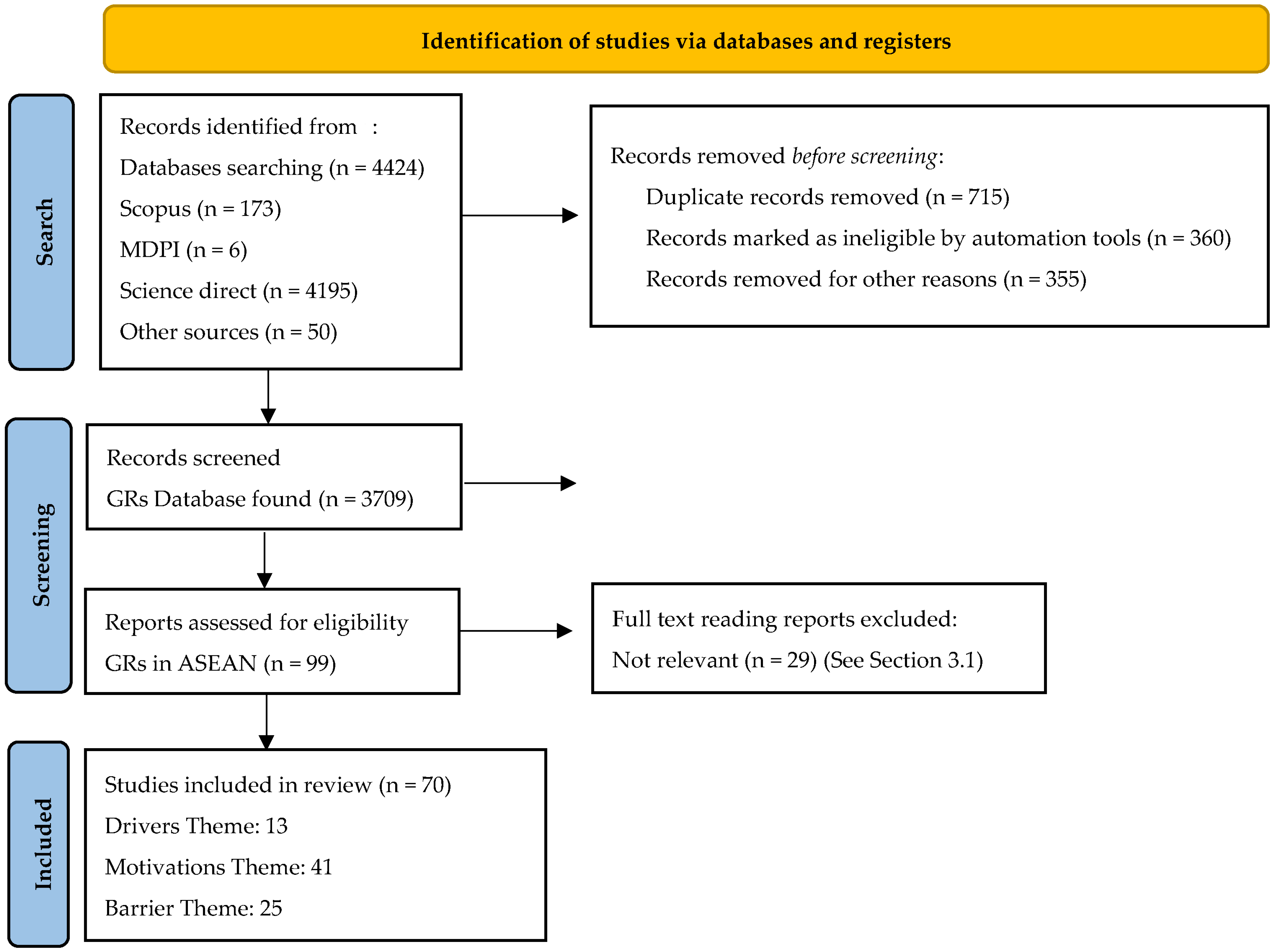
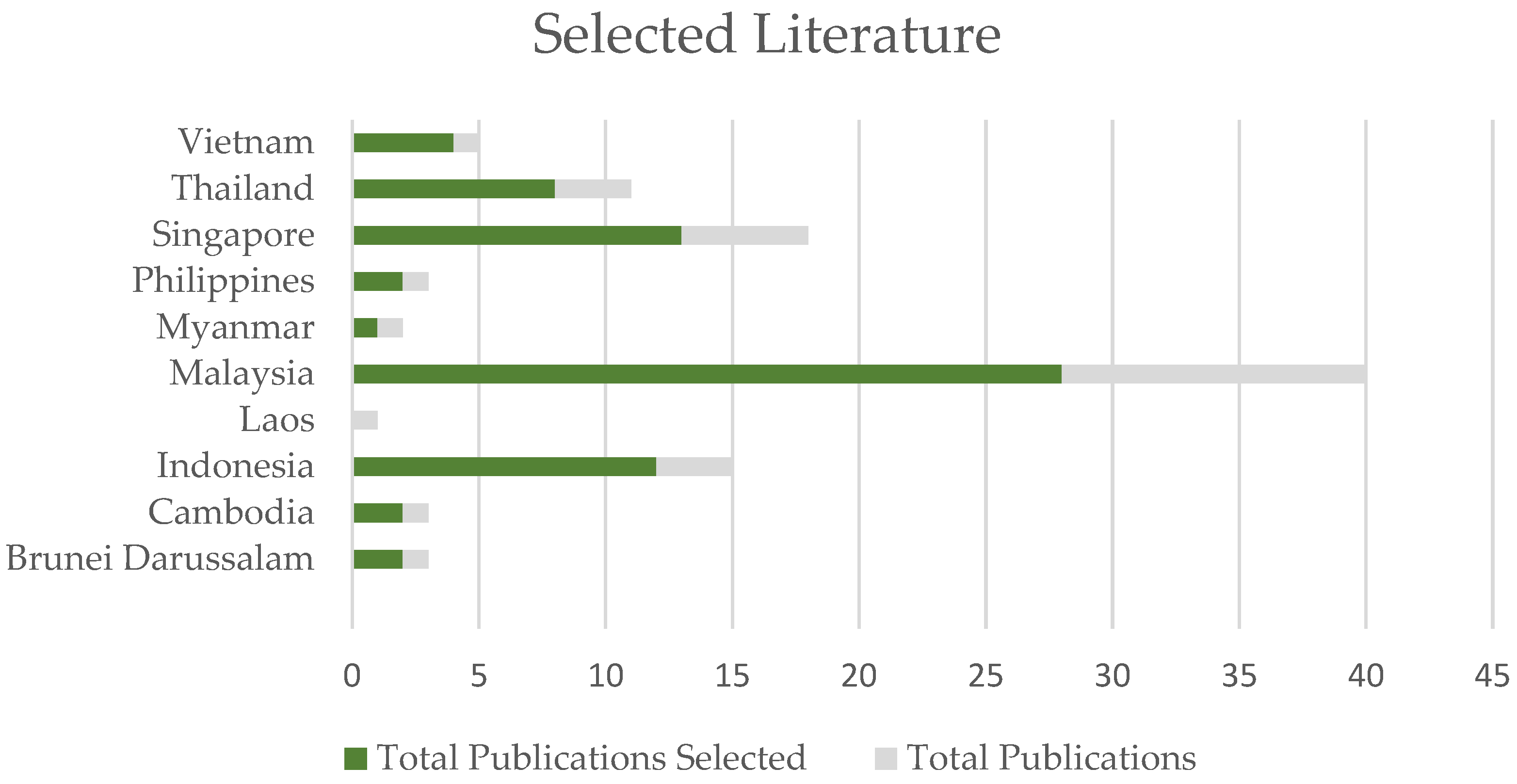
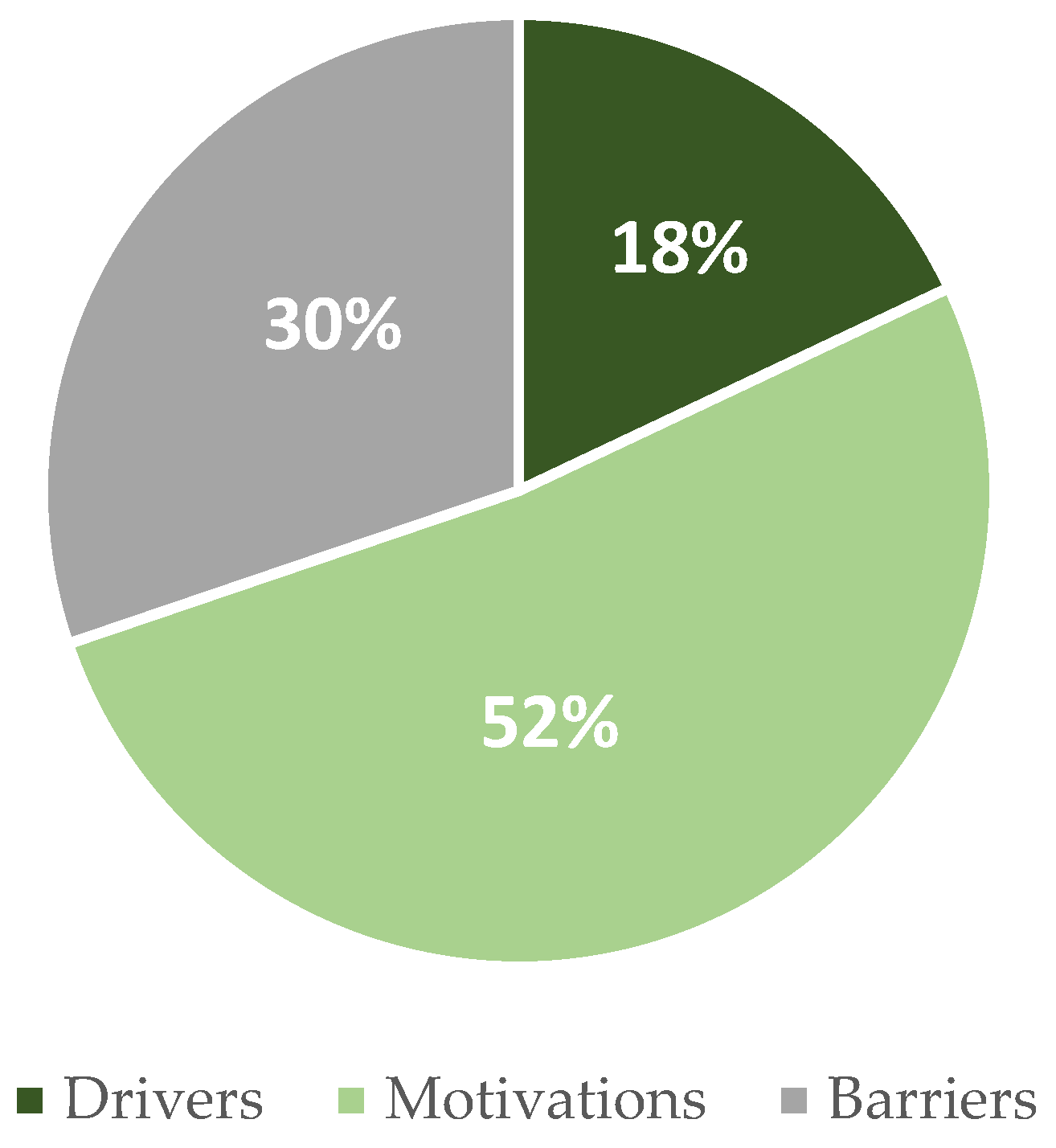
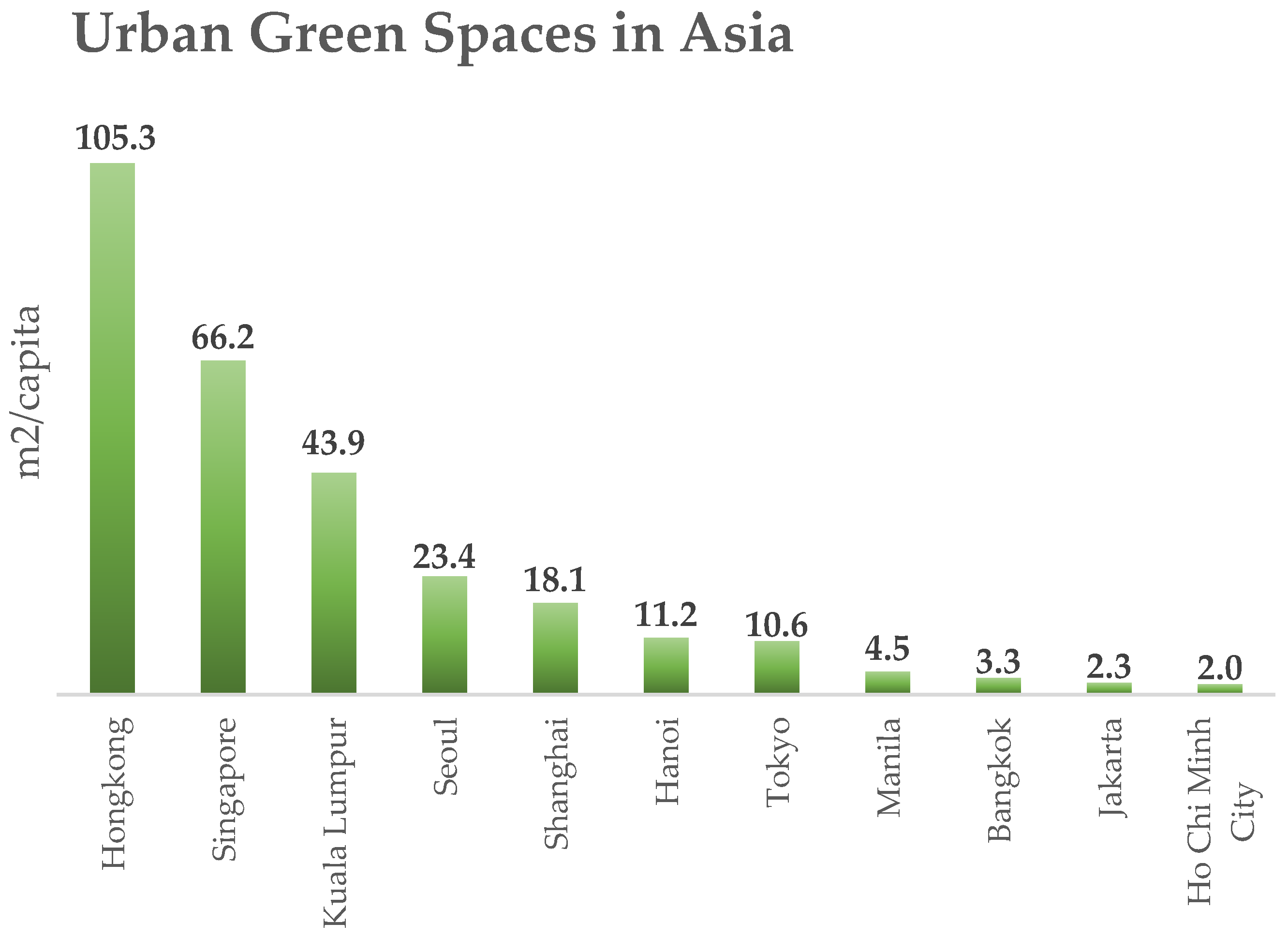


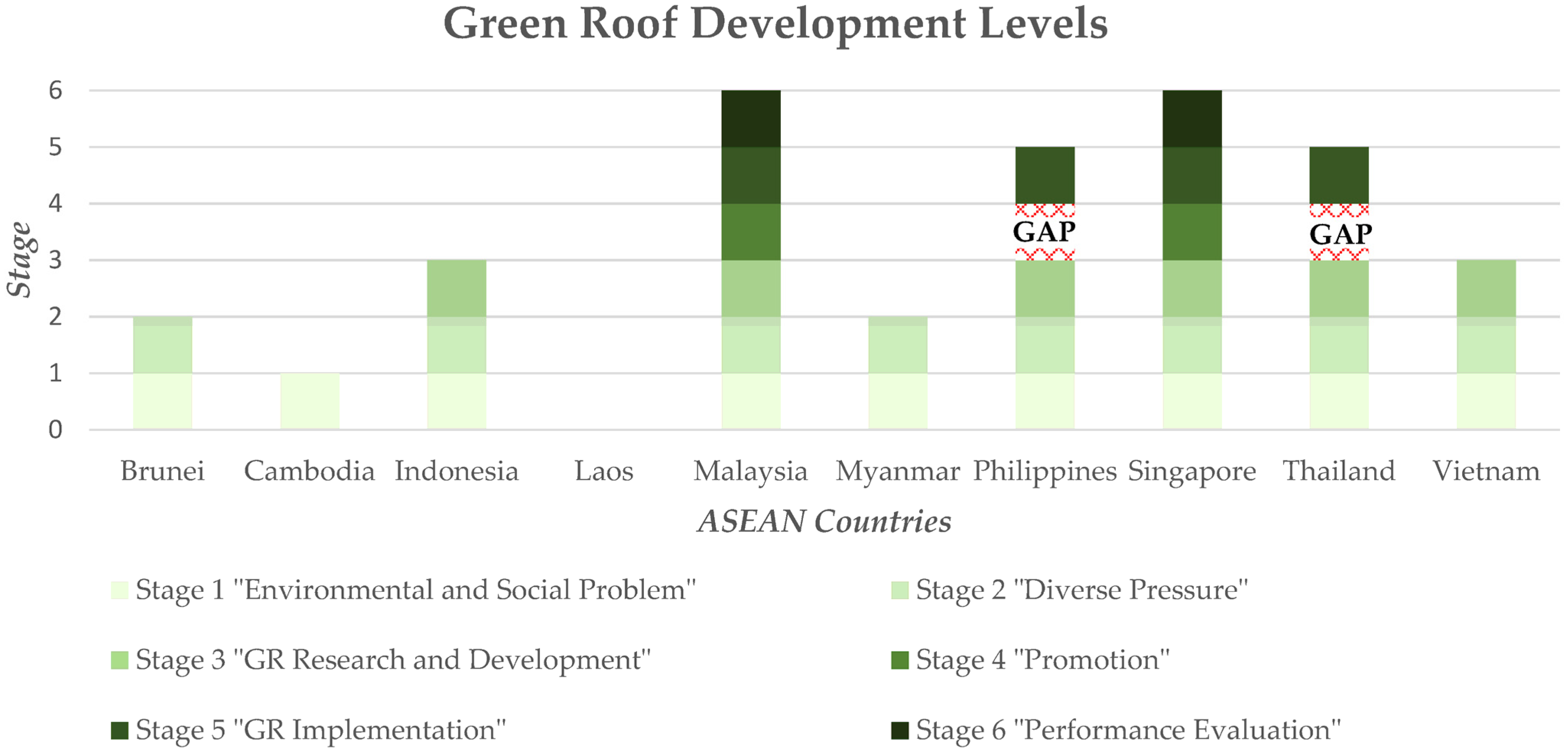
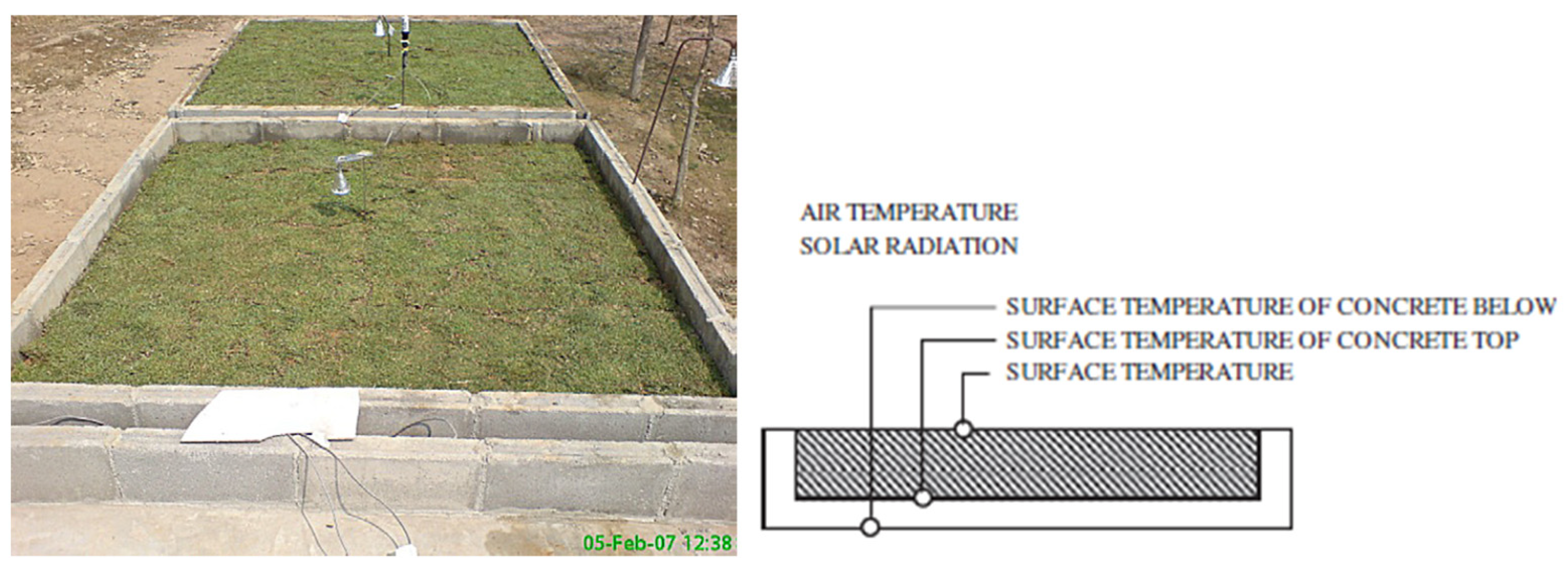
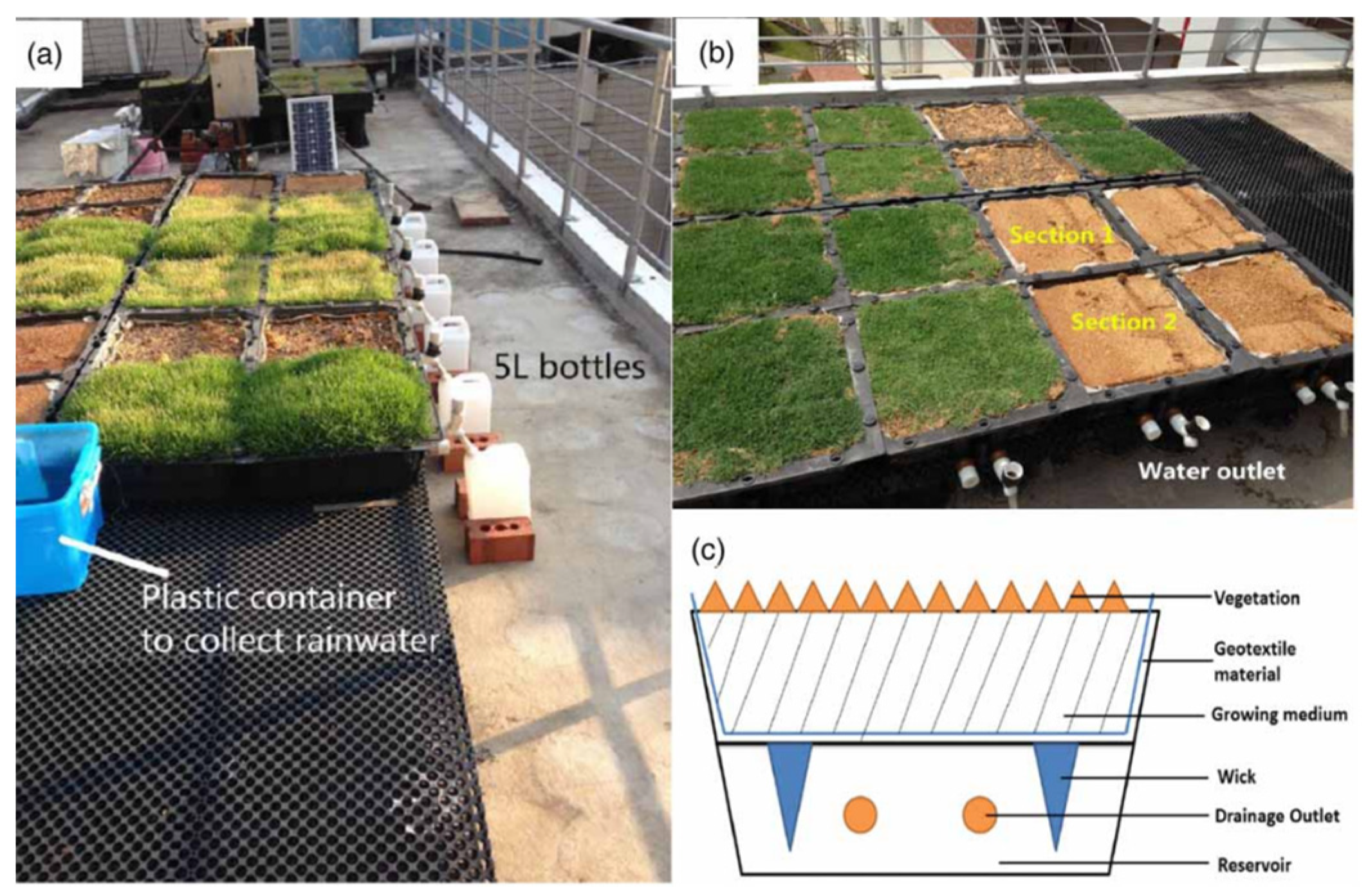
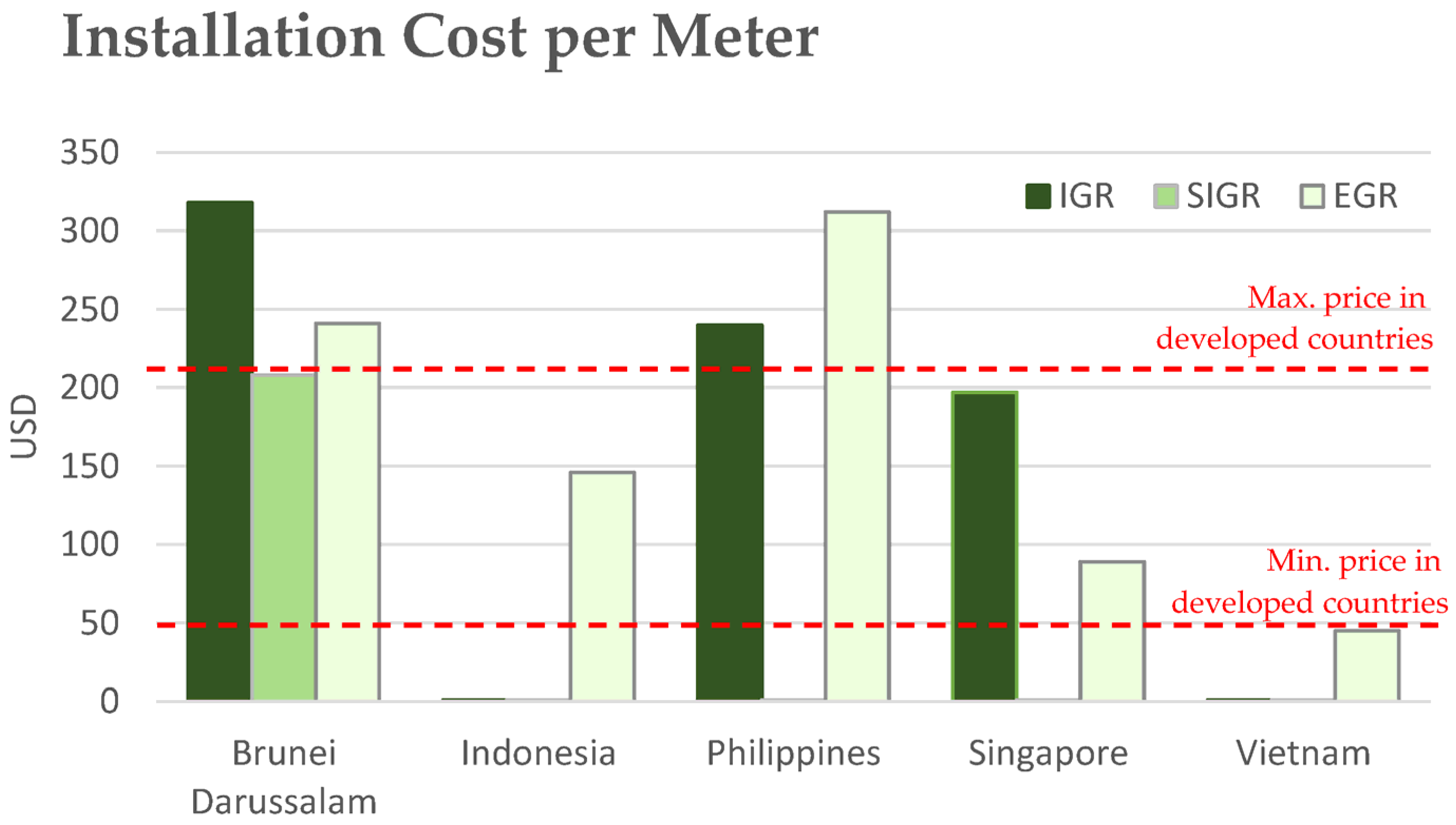
| Authors | Findings | Details |
|---|---|---|
| Mahdiyar et al. [32] | Development of a decision support system (DSS) for selecting the optimum type of GR for residential buildings in Kuala Lumpur | Malaysia, All types GR, System to selection GRs |
| He et al. [68] | Artificial neural network (ANN) models had a better average prediction for accurate modelling of thermal and hydrological performance | Singapore, EGR, Evaluate plant evapotranspiration |
| He et al. [70] | A methodology for a quick evaluation of thermal performance of a green roof during the early stages of design | Singapore, EGR, Model development of RTTV |
| Phoomirat et al. [33] | Develop a rapid assessment checklist (RAC) to assess GR services | Thailand, All GRs, Assessment tools |
| Munir et al. [31] | The panel 400 mm width is an optimal form for the structural roof deck of the green roof system | Indonesia, EGR, Structural deck precast foamed concrete for GRs |
| Shahid et al. [71] | Palm oil clinker has good ability to drain excess water, and there is no side effect in terms of plant development | Malaysia, EGR, Palm oil clinker as drainage layer |
| Chandra et al. [69] | Lightweight cellular concrete 1200 and 1400 kg/m3 meets the standard to substitute normal concrete | Thailand, EGR, Structural deck alternative for GRs |
| Authors | Energy Savings | Details |
|---|---|---|
| Wong et al. [74] | 1–15% reduction in energy consumption | Singapore, EGR, Comparison rooftop garden with turfing, shrubs, and tree |
| Dewi et al. [76] | 11.24–21% reduction in cooling load | Indonesia, EGR, GR simulations by planting Tradescantia Spathacea and Sedum acre |
| Sittipong and Pichai [73] | GR thickness 0.10 m–31.07% GR thickness 0.20 m–37.11% | Thailand, EGR, Increasing soil depth improves energy savings by around 6% |
| Azis et al. [75] | 37–40% reduction in energy consumption | Johor Bahru, Malaysia, EGR and IGR GR integration with 17-floor apartment |
| Yuliani et al. [77] | Concrete GRs, 57.1% reduction in heat flow Corrugated Zinc GRs, 50.8% reduction in heat flow | Surakarta, Indonesia, EGR, A corrugated zinc roof with plants could improve thermal conditions in a building |
| Authors | Max. Outdoor Surface Temperature Reduction | Ambient Temperature | Remarks |
|---|---|---|---|
| Sunakorn [79] | 10.4 °C | 30 °C | Thailand, Actual Survey Study, EGR, Local material Thailand (Green Mat) can be applied on GRs |
| Qin [80], Yang et al. [81] | 19 °C | 24–32 °C | Singapore, Simulation study, Cool roofs, Insulation layer on cool roofs plays a negligible role in heat flux values |
| Munir et al. [51] | 19.1 °C | 28–57 °C | Aceh, Indonesia, Experimental study, EGR, Precast foamed concrete, Combination of lightweight foamed concrete and GR |
| Ahmed and Rumana [82], Ismail et al. [83] | 19.8 °C | 30.2 °C | Malaysia, Actual survey study, Roof garden, GRs performed better than white concrete roof and gardening roof |
| Yuliani et al. [53,77] | 20 °C | 24–35 °C | Surakarta, Indonesia, Experimental study, EGR, Concrete and corrugated zinc, A corrugated zinc roof with plants could improve thermal conditions in a building |
| Azis et al. [75], Rahmat et al. [54], Rahman et al. [84] | 23.8 °C | 30–36 °C | Kuala Lumpur and Putrajaya, Malaysia, Experimental study, EGR, Green roof improving public environment |
| Yuliani et al. [53,77] | 20 °C | 24–35 °C | Surakarta, Indonesia, Experimental study, EGR, Concrete and corrugated zinc, A corrugated zinc roof with plants could improve thermal conditions in a building |
| Azis et al. [75], Rahmat et al. [54], Rahman et al. [84] | 23.8 °C | 30–36 °C | Kuala Lumpur and Putrajaya, Malaysia, Experimental study, EGR, Green roof improving public environment |
| Authors | Max. Indoor Temperature Reduction | Temperature Comparison | Remarks |
|---|---|---|---|
| Yuliani et al. [77] | 3 °C | GR 23–28 °C NON-GR 27–31 °C | Surakarta, Indonesia, Experimental study, EGR, Concrete and corrugated zinc, A corrugated zinc roof with plants could improve thermal conditions in a building |
| Pahm et al. [62] | 3 °C | GR 31 °C NON-GR 34 °C | Ho Chi Minh City, Vietnam, Actual survey study, roof garden In cooler area, GR still resulted lower than non-GR temperature |
| Ahmed and Rumana [82], Ismail et al. [83], Rahman et al. [84] | 3 °C | GR 24.5–31.5 °C NON-GR 25.5–33 °C | Malaysia, Actual survey study, roof garden, GRs performed better than white concrete roof and gardening roof |
| Irsyad et al. [35] | 6.8 °C | GR 23–26 °C NON-GR 24–32 °C | Bandung, Indonesia, Experimental study, EGR, The use of Amaranta and Bromelia plants can inhibit heat transfer into the room |
| Sunakorn [79] | 7 °C | GR 24.6–27.9 °C NON-GR 29.6–39.9 °C | Thailand, Actual survey study, EGR, Local material Thailand (Green Mat) can be applied on GRs |
| Munir et al. [51] | 10.2 °C | GR 35–38 °C NON-GR 42–51 °C | Aceh, Indonesia, Experimental study, EGR, Precast foamed concrete Combination of lightweight foamed concrete and green roof |
| Yang et al. [81] | 14 °C | GR 26–27 °C NON-GR 28–41 °C | Singapore, Simulation study, EGR, Insulation layer on cool roofs plays a negligible role in heat flux values |
| Authors | Water Retention Capacity | Remarks and Influence Factors |
|---|---|---|
| Chanrachna et al. [49] | 37.90% | Phnom Penh, Cambodia, Comparison study, GI (Green Infrastructure) scenario by installation tree, bioswales, permeable pavements, and green roofs |
| Cuong et al. [85] | 42% | Hanoi, Vietnam, Experimental study, EGR, Four models with different irrigation systems |
| Asinas et al. [57] | 46% | Philippines, Experimental study, EGR, Waterproof substrate improving water retention by adding hydrogel to substrate media |
| Chai et al. [87] | 72.5% | Kuching, Malaysia, Simulation study, EGR, Green roof water balance by virtual modelling approach |
| Orozco et al. [36] | 75% | Metro Manila, Philippines, Comparison study, EGR, Suppliers company, Comparison of suppliers with six different GR technologies |
| Ayub et al. [88], Fai et al. [89], Chow et al. [90], Romali et al. [37], Kok et al. [91], Chai et al. [87], Musa et al. [92] | 86% | Malaysia, Simulation study, EGR, GRs decrease of stormwater runoff, Types of substrates resulting in different runoff, Mixture of plant species was the most effective vegetation at reducing runoff water |
| Vergroesen and Joshi [93] | 98.8% | Singapore, Experimental study, EGR, 3-day experiment, Different sedum comparison |
| Authors | Findings | Remarks and Influence Factors |
|---|---|---|
| Romali et al. [37] | GRs with beach morning glory improve the COD up to 99% GRs with creeping oxeye reduce the BOD up to 17% | Malaysia, Experimental study, EGR, Green roof with beach morning glory and creeping oxeye |
| Lim et al. [94] | Mixture substrate clay (5–30%), silt (5–60%), and sand (20–75%) can decline in chemical concentration level | Singapore, Experimental study, EGR, Substrate comparison |
| Vijayaraghavan et al. [97] | The concentrations of most of the chemical components in runoff were highest during the beginning of rain events and subsided in the subsequent rain events | Singapore, Experimental study, EGR, Real rain events and ten different simulated rain events |
| Authors | Findings | Remarks |
|---|---|---|
| Suparwoko and Taufani [111] | The potential to use GRs as an urban farming space | Sleman, Indonesia, Survey study, Feasibility of buildings |
| Chow and Abu Bakar [102] | Industries were very cautious about having rooftop gardens due to the unknown risk on maintenance aspects | Malaysia, Survey study, Feasibility of buildings |
| Rahman et al. [112] | GRs help to regenerate and revitalize the commercial setting in urbanized areas | Malaysia, Survey study, Feasibility of buildings |
| Hwang and Roscoe [113] | Green roofs as a platform for the interaction between humans and nature is a possibility that is yet to be fully explored, especially in a tropical context | Singapore, Actual study, Feasibility of buildings |
| Naing et al. [114] | 47% of selected buildings in sampling area were possible to retrofit for a green roof | Thailand, Survey study, Feasibility of buildings |
| Jalanugroh and Tikul [115] | Of twenty-six education buildings, three can be built with an intensive green roof, seven can be built but gardeners are needed, and sixteen can be built with extensive green roofs | Thailand, Survey study, Feasibility of buildings |
| Lwin and Panuwatwanich [108] | Energy efficiency, water efficiency, and waste and pollution, are the most crucial categories that should be concerned | Myanmar, Survey study, Feasibility of buildings |
Disclaimer/Publisher’s Note: The statements, opinions and data contained in all publications are solely those of the individual author(s) and contributor(s) and not of MDPI and/or the editor(s). MDPI and/or the editor(s) disclaim responsibility for any injury to people or property resulting from any ideas, methods, instructions or products referred to in the content. |
© 2023 by the authors. Licensee MDPI, Basel, Switzerland. This article is an open access article distributed under the terms and conditions of the Creative Commons Attribution (CC BY) license (https://creativecommons.org/licenses/by/4.0/).
Share and Cite
Pratama, H.C.; Sinsiri, T.; Chapirom, A. Green Roof Development in ASEAN Countries: The Challenges and Perspectives. Sustainability 2023, 15, 7714. https://doi.org/10.3390/su15097714
Pratama HC, Sinsiri T, Chapirom A. Green Roof Development in ASEAN Countries: The Challenges and Perspectives. Sustainability. 2023; 15(9):7714. https://doi.org/10.3390/su15097714
Chicago/Turabian StylePratama, Hanny Chandra, Theerawat Sinsiri, and Aphai Chapirom. 2023. "Green Roof Development in ASEAN Countries: The Challenges and Perspectives" Sustainability 15, no. 9: 7714. https://doi.org/10.3390/su15097714
APA StylePratama, H. C., Sinsiri, T., & Chapirom, A. (2023). Green Roof Development in ASEAN Countries: The Challenges and Perspectives. Sustainability, 15(9), 7714. https://doi.org/10.3390/su15097714







